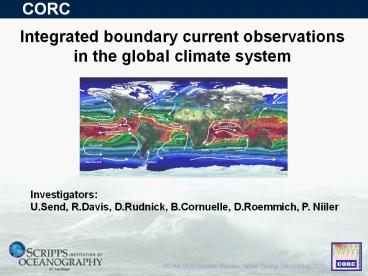Integrated boundary current observations - PowerPoint PPT Presentation
1 / 28
Title:
Integrated boundary current observations
Description:
Integrated boundary current observations in the global climate system Investigators: U.Send, R.Davis, D.Rudnick, B.Cornuelle, D.Roemmich, P. Niiler – PowerPoint PPT presentation
Number of Views:66
Avg rating:3.0/5.0
Title: Integrated boundary current observations
1
CORC
Integrated boundary current observations in the
global climate system
Investigators U.Send, R.Davis, D.Rudnick,
B.Cornuelle, D.Roemmich, P. Niiler
NOAA OCO System Review, Silver Spring, 29 October
2010
2
OceanObs09 boundary currents are a
critical gap
- CORC objective
- develop and demonstrate efficient integrated
technologies and methodologies to fully
characterize and observe - western boundary currents - major factor
in driving climate - societal relevance by
understanding and forecasting - eastern boundary currents - major impact of
climate - societal relevance by understanding
and for management/mitigation - After an intensive phase in a region, leave
behind a reduced efficient system.
3
Technology developments in CORC
Bottom-release pop-up surface drifters (7
released sequentially from 2000m depth this
year).
Acoustic data retrieval from long-term lower-cost
fixed subsurface instrumentation
4
Acoustic data recovery success with gliders
5
Western Boundary Current in the Solomon Sea
(feeding EUC)
typical glider path
see Kessler poster
bottom pressure
- now 2 gliders in water at any time
- large transport variability, similar to ARGO
- relation to La Nina/El Nino
- remove eddy noise and add higher temporal
sampling by adding modem PIES across basin in
the future
6
Testbed and Eastern Boundary Current site
California Current
- - Integrate glider, XBT, mooring, drifter obs.
- - Staggered coverage from coast to interior
- - Capitalize from CalCOFI data, merge with
altimeter and ARGO - - state estimate from adjoint model
7
XBT and ARGO sampling, connecting to basin
interior
8
Glider alongshore flow mean and 0-500m
variability
Line 90
Line 80
3 years of glider data now
Line 90
9
El Nino signal in glider observations of the
California Current
Equatorial SST
Anomalies averagedover 200km along line 90(T,
isopycnal depth, S, v)
wind and curl
10
Sampling domains of gliders, moorings, PIES
11
Mooring transports, flow profile, reference
level, bottom pressure
Geostrophic transport very sensitive
toreference level
bottom pressure gradientscontribute 1Sv to
transport
mean flow profile,zero near 300m. Deeper ref
level givessouthward bias
12
Water column heat content from moorings and IES
Co-located mooring and IES
IES only
Co-located mooring and IES
13
CORC surface drifter observations and analyses
Mean surface flow from drifters 1992-2008
1 year of CORC drifter trajectories
14
CORC state estimates via MITgcm adjoint
assimilation
- MITgcm model description
- 6km resolution, 72 levels, 20min timestep
- 4DVar adjoint
- initialboundary cond from MIT ECCO
- atmosphere from NCEP NAM
- data from Jan07 - Jul09 - altimetry and
satellite SST - ARGO ship hydrography
(CalCOFI) - glider TS, XBT - mooring
TS - soon IES, bottom pressure, drifters - control variables - ICs and BCs -
surface forcing - dynamically consistent state estimates
- ongoing improvements/iterations (90 now)
Model domain (gray box)
15
Model-mooring and model-glider comparison for
mean flow
glider
mooring model
model
16
Model-mooring and model-glider comparison for
time-dependent flow
glider
model
mooring model
17
Wind stress curl field diagnosed from state
estimate
Needed model to estimate wind stress curl
inshore curl isopycnal depth(2 month lag)
18
CORC model state estimate improves shortwave
heatflux
The model managed to correct shortwave heat flux
using in-situ observations
NCEP NAM
Rms difference between new CayanIacobellis
satellite product and various estimates
Cayan product
NAM adjusted by adjoint
19
CORC model state estimate products page (used by
NOAA SWFSC)
Cannot rely on single proxy or measurement for
managing fisheries (e.g. Temp in Southern
California Bight, relation can break down). See
Ned Cyr presentation.
20
New short-term (17day) assimilation experiments
using ROMS
- Model
- 9km horizontal resolution nested in 18km
- Initial and boundary conditions from OCCA
- Surface forcing fields were from NCEP NAM
- assimilation 2008.10.11 to 2080.10.28
- corrects initial condition, wind forcing,
surface heat flux and the open boundary - Observations
- Alongtrack sea surface height data (AVISO)
- Sea surface temperature (AVHRR)
- CalCOFI temperature and salinity
- Mooring data
- glider data
- ARGO
Short runs allow operational data assimilation
21
Snapshots of alongshore flow field in short-term
assimilation
22
Normalized cost for glider/mooring data after 9
iterations
glider T mooring T
glider S mooring
S
Section transport timeseries
23
Conclusions and proposed next phase
- large variability in flow and transport,
dominated by eddies and Rossby waves - by summer 2011 will have 5½ years of glider
data and 3 years of mooring/PIES ? can
analyze low-frequency transports and compare with
XBT/ARGO - adjoint model/state estimates will be brought to
consistency with data - short-term now-cast technique will be refined
- research ongoing into constraining transports
more directly
- Next phase
- develop capability for capturing the upwelling
overturning circulation - add alongshore resolution for constraining 4-D
field - study trade-off and efficiencies between XBT,
gliders, moorings, bottom pressure sensors - deliver weekly estimates of upwelling
circulation - seasonal hindcasts of physical system driving
ecosystem and OA - maps onto Lindstrom requirements/societal
drivers and outputs
24
Roemmich 89, Bograd et al 01 upwelling
overturning transports
25
Integrated glider and mooring sampling plan
CORC present
glider occupations of box
Daily glider sections
moorings for daily nettransport estimates
SCCOOS
Close transport inshoreof 500m isobath
Peter
add existing lines foralongshore resolution
CORC present
resolve alongshorestructure/connectivity (Peter
Niiler memorial)
Geostrophic moorings, possibly virtual moorings
26
Extras.
27
(No Transcript)
28
Space-time sampling of gliders and CalCOFI in the
California Current
Line 90































